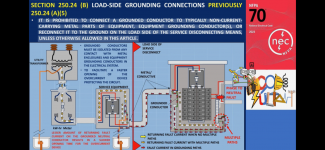dm9289
Industrial Maintenance Electrician
- Location
- Pennsylvania
- Occupation
- Industrial process repair/ maintenance Electrician
I was studying and a graphic came up that confused me slightly. The graphic is attached below. the point of the graphic was if you connect the neutral and gnd together after the first means of disconnect you will cause the breaker to trip later during a fault.
My "belief" is return current path is based on impedance.
For example I=V/R so if return path is 2 ohm thru neutral 120v/1=120amp
2 return paths ground and neutral linked in sub panel or past first disconnect with alternate path 3 ohm. So my feeling would be the total impedance would be product over sum (3x1)/(3+1)= .75 ohms
I=V/R 120/.75=160amps so my belief is breaker would trip sooner with 2 paths
I realize I'm likely wrong and missing a basic concept and your help is appreciated. I do also understand this creates objectionable current which is not desired and not code compliant.
My "belief" is return current path is based on impedance.
For example I=V/R so if return path is 2 ohm thru neutral 120v/1=120amp
2 return paths ground and neutral linked in sub panel or past first disconnect with alternate path 3 ohm. So my feeling would be the total impedance would be product over sum (3x1)/(3+1)= .75 ohms
I=V/R 120/.75=160amps so my belief is breaker would trip sooner with 2 paths
I realize I'm likely wrong and missing a basic concept and your help is appreciated. I do also understand this creates objectionable current which is not desired and not code compliant.


